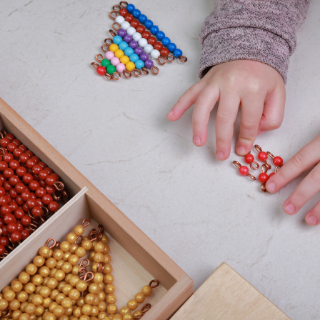
This math lesson is designed for 3 to 6-year-old children to help them practice multiplication using bead bars.
In our previous video lesson, we learned about counting with bead bars. In this video, we will learn how to multiply using Montessori bead bars.
Montessori bead bars come with strings of numbers 1 to 9. It also guides the child to form multiples of numbers from 1 to 9, using bead bars, and introduces them to multiplication tables.
Multiplication is an essential skill for children to learn, but it can often be challenging to teach and grasp. The Montessori approach to multiplication offers a unique and effective way to teach children this complex concept. This approach involves using hands-on learning with bead bars and practicing multiplication skills.
Learning the complex concept of multiplication, Montessori bead bars allow children to visualize multiplication and understand the relationships between numbers.
Benefits of using Multiplication Bead Bars
- Engaging and interactive
- A concrete representation of abstract concepts
- Encourages independent learning
Montessori bead bars are a versatile mathematical tool in the Montessori curriculum. They are engaging and provide a concrete representation of abstract mathematical concepts that can be difficult for children to understand.
By working with the beads on their own, children can explore and experiment with multiplication in their own way. This can help to build their confidence and self-esteem, as well as their understanding of mathematical concepts.
By working with the beads on their own, children can explore and experiment with multiplication independently in their own way. This can help to build their confidence and self-esteem, as well as their understanding of mathematical concepts.
How to Introduce Multiplication Beads Bars to the Child?
To introduce multiplication using Montessori bead bars, first, the child should have a firm understanding of addition and counting.
- Invite the child to the table along with the beads bar box. Start by introducing the concept of multiplication.
- Grouping: Start by showing the child how to group the beads into sets of two, three, or four to create simple multiplication problems. For example, you can show them how to group two sets of two beads to create a problem like 2 x 2 = 4.
- Bead Bar Practice: After introducing the concept of grouping, give the child a set of bead bars and ask them to create different multiplication problems. You can start with simple problems like 2 x 2 or 3 x 3 and gradually move on to more complex problems.
- Writing Expressions: Encourage the child to write the multiplication problems they create using the bead bars in a practice book. This helps them practice writing expressions and reinforces the concept of multiplication.
- Creating Their Own Problems: As the child becomes more comfortable with multiplication, encourage them to create their own problems using the bead bars. You can ask them to create problems with specific multiples, such as multiples of three or four.
- Problem-Solving: Finally, challenge the child to solve more complex multiplication problems using the bead bars. You can give them problems with larger numbers or problems that require multiple steps to solve. This helps them develop problem-solving skills and reinforces their understanding of multiplication.
Examples of Multiplication using Montessori Bead Bars
Here are some examples of multiplication problems using Montessori bead bars:
- 2 x 2 = (two groups of two beads) = 4 beads
- 3 x 3 = (three groups of three beads) = 9 beads
- 4 x 2 = (four groups of two beads) = 8 beads
- 5 x 4 = (five groups of four beads) = 20 beads
- 6 x 3 = (six groups of three beads) = 18 beads
This practical method is a fun and innovative way to instill a sense of logical thinking in the child. This would help them to get a better understanding of the math concepts.
Let the child solve more and more complex math problems as they learn multiplication using Montessori beads bars as shown in the video.
Related Video Resources
- Learning Multiplication using Flat Bead Frame
- Learning numbers using hanging bead stairs
- Multiples and factors tables A, B and C
- Montessori stamp game multiplication
Video Created by: Joanne Shang
Tags





